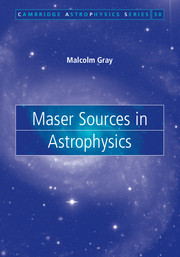46 results
Overview of the Maser Monitoring Organisation
-
- Journal:
- Proceedings of the International Astronomical Union / Volume 18 / Issue S380 / December 2022
- Published online by Cambridge University Press:
- 07 February 2024, pp. 443-451
- Print publication:
- December 2022
-
- Article
- Export citation
Masers in accretion burst sources
-
- Journal:
- Proceedings of the International Astronomical Union / Volume 18 / Issue S380 / December 2022
- Published online by Cambridge University Press:
- 07 February 2024, pp. 152-158
- Print publication:
- December 2022
-
- Article
- Export citation
ALMA explores the inner wind of evolved O-rich stars with two widespread vibrationally excited transitions of water
-
- Journal:
- Proceedings of the International Astronomical Union / Volume 18 / Issue S380 / December 2022
- Published online by Cambridge University Press:
- 07 February 2024, pp. 351-355
- Print publication:
- December 2022
-
- Article
-
- You have access
- Open access
- Export citation
Tracing the inner regions of circumstellar envelopes via high-excitation water transitions
-
- Journal:
- Proceedings of the International Astronomical Union / Volume 16 / Issue S366 / November 2020
- Published online by Cambridge University Press:
- 30 November 2022, pp. 199-203
- Print publication:
- November 2020
-
- Article
-
- You have access
- Open access
- Export citation
Notes on Contributors
-
-
- Book:
- The Cambridge Companion to the City in Literature
- Published online:
- 05 October 2014
- Print publication:
- 06 October 2014, pp xi-xiv
-
- Chapter
- Export citation
Australia's Role in Gravitational Wave Detection
-
- Journal:
- Publications of the Astronomical Society of Australia / Volume 20 / Issue 3 / 2003
- Published online by Cambridge University Press:
- 05 March 2013, pp. 223-241
-
- Article
-
- You have access
- Export citation
2 - Discovery
-
- Book:
- Maser Sources in Astrophysics
- Published online:
- 05 May 2012
- Print publication:
- 26 April 2012, pp 33-75
-
- Chapter
- Export citation
References
-
- Book:
- Maser Sources in Astrophysics
- Published online:
- 05 May 2012
- Print publication:
- 26 April 2012, pp 392-414
-
- Chapter
- Export citation

Maser Sources in Astrophysics
-
- Published online:
- 05 May 2012
- Print publication:
- 26 April 2012
Appendix D - Change of variables in integration
-
- Book:
- Maser Sources in Astrophysics
- Published online:
- 05 May 2012
- Print publication:
- 26 April 2012, pp 369-370
-
- Chapter
- Export citation
Index
-
- Book:
- Maser Sources in Astrophysics
- Published online:
- 05 May 2012
- Print publication:
- 26 April 2012, pp 415-419
-
- Chapter
- Export citation
Appendix J - Matrices
-
- Book:
- Maser Sources in Astrophysics
- Published online:
- 05 May 2012
- Print publication:
- 26 April 2012, pp 385-386
-
- Chapter
- Export citation
4 - Observations of masers
-
- Book:
- Maser Sources in Astrophysics
- Published online:
- 05 May 2012
- Print publication:
- 26 April 2012, pp 113-155
-
- Chapter
- Export citation
Appendix G - Local standard of rest
-
- Book:
- Maser Sources in Astrophysics
- Published online:
- 05 May 2012
- Print publication:
- 26 April 2012, pp 377-377
-
- Chapter
- Export citation
3 - Basic theory
-
- Book:
- Maser Sources in Astrophysics
- Published online:
- 05 May 2012
- Print publication:
- 26 April 2012, pp 76-112
-
- Chapter
- Export citation
10 - Future prospects
-
- Book:
- Maser Sources in Astrophysics
- Published online:
- 05 May 2012
- Print publication:
- 26 April 2012, pp 352-361
-
- Chapter
- Export citation
8 - Computer modelling
-
- Book:
- Maser Sources in Astrophysics
- Published online:
- 05 May 2012
- Print publication:
- 26 April 2012, pp 294-326
-
- Chapter
- Export citation
6 - Environments of masers
-
- Book:
- Maser Sources in Astrophysics
- Published online:
- 05 May 2012
- Print publication:
- 26 April 2012, pp 186-240
-
- Chapter
- Export citation
Appendix K - The centre of mass frame
-
- Book:
- Maser Sources in Astrophysics
- Published online:
- 05 May 2012
- Print publication:
- 26 April 2012, pp 387-388
-
- Chapter
- Export citation
Appendix H - Stochastic processes
-
- Book:
- Maser Sources in Astrophysics
- Published online:
- 05 May 2012
- Print publication:
- 26 April 2012, pp 378-381
-
- Chapter
- Export citation



